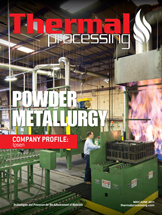It is hard to find a market segment that has not benefited from technology advancements. Heat-treating process control is no different. While there are variations between heat-treating processes, the goal is the same: altering the metallurgical properties of a part using time, temperature, and, in some cases, the atmosphere it is exposed to.
Control- and process-related documentation and technology are riddled with industry buzzwords that can be heard or read in any technical publication or interview. Optimization, IoT (Internet of Things), KPI (key performance indicators), smart technology, and predictive planning are just a few, and the list goes on. With that said, these are all relevant when considering where process control is today and where it will be tomorrow. Technology weaves its path into platforms used in the most sophisticated, as well as the simplest, of operations. Today’s heat treater benefits from technology to help reduce errors on the shop floor, make better decisions, and provide a quality product.
This discussion will cover what heat treaters are doing today and what they are looking at in the future — by identifying existing technology being used with current equipment and looking at some of the new equipment and capabilities being provided.
Process control starts with a sensor connected to a control instrument. This instrument reacts to the reading by altering the state. In the simplest form, this is a thermocouple used to measure temperature, connected to a microprocessor-based controller that uses an algorithm to alter the heating/cooling output to achieve the desired set point. In today’s heat-treat environments, you see a wide variation of equipment to address process controls. Some are current technologies, and some are older than one might think.
 The state of process controls today is, in many cases, driven by the functionality of the equipment in use, for example, the furnace/oven. The latest furnace equipment is set up with all the bells and whistles that provide feedback on the current operating variables, the health of the equipment, and enhanced system methods using more sensors and controls. Because of the capital expenditure on the actual furnace equipment, many existing furnaces are updated with more current control and sensor technology, providing a “current” operating environment on the older equipment. These retrofits are usually feature-rich and only limited to the investment the end user wants to make on controls and sensors.
The state of process controls today is, in many cases, driven by the functionality of the equipment in use, for example, the furnace/oven. The latest furnace equipment is set up with all the bells and whistles that provide feedback on the current operating variables, the health of the equipment, and enhanced system methods using more sensors and controls. Because of the capital expenditure on the actual furnace equipment, many existing furnaces are updated with more current control and sensor technology, providing a “current” operating environment on the older equipment. These retrofits are usually feature-rich and only limited to the investment the end user wants to make on controls and sensors.
In many cases, industry standards such as CQI-9 and AMS provide guidelines for process control, sensors, and accuracy. CQI-9, the automotive industry’s heat-treat self-assessment, calls out specific tolerances required for control instrument calibration sensitivity and calibration frequencies for control and monitoring equipment. CQI-9 also provides guidelines for heat-treatment process monitoring to address parameters needed for real-time control and monitoring. Examples include the control monitoring of temperature and atmosphere for carburizing applications, daily verification of atmosphere using alternate testing methods, and microstructure verification for each batch.
The ASM standards provide guidelines for heat-treat providers to run parts as well. The ASM standards cross-reference these specific processes. For example, the ASM 2759/7 specification addresses nitriding applications but also references ASM 2750 for pyrometry. The specifications will call out necessary steps for the control, monitoring, and verification of the process being performed.
Technology today is being used to address tighter tolerances for high-quality work. The ultimate goal is providing a high-quality part to meet the performance standards set forth by the design engineer. Sensors and controls today provide redundancy and a level of smartness to ensure that the disruption to a heat-treatment process is limited.
One of the most significant cost factors in heat treatment is scrap and rework. Today’s smart controllers provide the highest level of user friendliness to eliminate operator error and reduce mis-heat-treated parts. Automation of process control from the start provides the foundation for achieving a properly heat-treated part. Trends in automation are not necessarily removing workers from jobs but rather repurposing those individuals. Likewise in heat treating, operators can spend less time in areas of entering, monitoring, checking, and reviewing to allow for exception management, giving them opportunities to optimize, consolidate, prepare, and anticipate.
Multifunction process controllers allow for smart algorithms that go beyond the traditional PID (proportional, integral, and derivative) control. Any process controller in use today uses this algorithm to meet a desired set point using the process output. Expanding on this are even more options to provide greater functionality around controls that allow for limiting output, trimming specific control zones, auto-selecting by set point, overshoot suppression, and fuzzy logic. The reality is there are endless options for setting up controls when engineering a system. But even with everything that can be engineered, there is a limitation to implementation time and investment. The good news is that out-of-the-box functionality addressing heat treatment process control is rich in features and cost-effective.
Smart controllers provide immediate reference to key parameters that enable a true preventative maintenance system. The days of reactive maintenance are slowly being phased out with the use of smart controls, data acquisition, and redundant sensors.
Controls today are represented by discrete microprocessor controllers, multi-loop process controllers, programmable logic controllers (PLC), computer-based controls, and a combination of all these variations. PLCs and hybrid controllers represent a flexible control scheme that allows specific logic to be developed and programmed to meet the desired design requirements of the equipment. Expanded logic can include additional features, in many cases, only limited by the programmer’s available bandwidth. Caution should be taken when implementing a control system. Availability of replacement parts, support of functionality, and even over-engineering is a common pitfall. What is right for the end user isn’t always the most sophisticated system and may not be the least expensive. Business drivers for control solutions should be defined that allow for the controls integrator or equipment supplier to provide you with the right solution to meet your business requirements.































